As someone who’s always got an eye on the ever-shifting world of SEO, I’m constantly on the hunt for tactics that can give my clients that extra edge. After all, their success is how I measure mine. Let’s dive into some lesser-known SEO strategies I’ve been exploring lately.
1. Embracing Entity Salience: Forget the old days of just cramming keywords. It’s all about the bigger picture now. By focusing on the main ideas or ‘entities’ in content, I’ve found a way to align with Google’s thinking process, making content more relevant and impactful.
Let’s break down the concept of Entity Salience and provide a practical example to illustrate its significance.
What is Entity Salience?
Entity Salience refers to the prominence or importance of specific concepts or ‘entities’ within a piece of content. An entity is not just a keyword; it’s a distinct idea or thing that can be identified. Google’s algorithms have evolved to recognize these entities and understand their importance within the context of the content. By emphasizing salient entities, content creators can make their material more contextually relevant to search engines.
Example:
Let’s consider a blog post about Apple. Instead of just focusing on the keyword “Apple,” we’ll identify and emphasize key entities related to the topic.
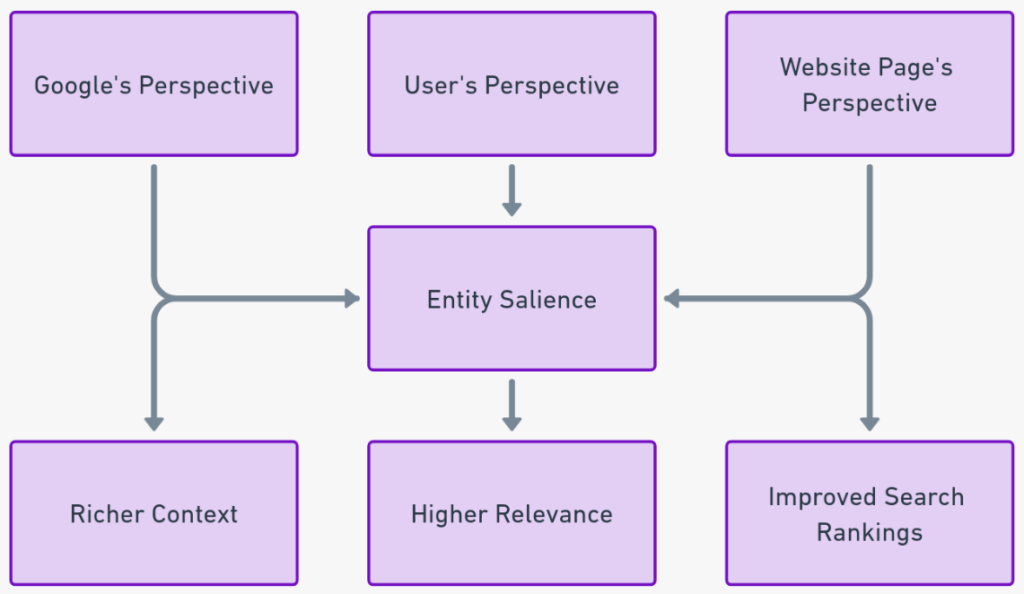
Old Approach (Keyword-centric): “Apple has released a new iPhone. This Apple product has advanced features. Apple’s latest offering is expected to be a hit.”
New Approach (Entity Salience): “Apple, the tech giant, has unveiled its latest iPhone model. Known for its innovative technology, the company’s newest product boasts advanced features that set it apart in the smartphone market.”
In the new approach:
- The entity “Apple” is clearly identified as a “tech giant,” distinguishing it from the fruit.
- The entity “iPhone” is contextualized as a “smartphone” and as Apple’s “newest product.”
- The emphasis on “innovative technology” provides context about Apple’s reputation in the tech industry.
By focusing on these entities and their relationships, the content provides a richer context, making it more relevant to both readers and search engines. This approach aligns with Google’s understanding of content, ensuring that the material is not only keyword-rich but also contextually meaningful.
2. Talking the Talk with Voice Search: Voice-activated gadgets are everywhere! I’ve been helping clients optimize for voice searches by focusing on natural, conversational phrases. Think about how you’d ask Siri or Alexa a question, and you’re on the right track.
Let’s delve deeper into the concept of Voice Search Optimization and provide a tangible example to clarify its importance.
What is Voice Search Optimization?
Voice Search Optimization is the process of enhancing content to cater to voice-activated searches. With the proliferation of smart speakers and voice assistants like Siri, Alexa, and Google Assistant, more people are using their voices to search the web. These searches tend to be more conversational and question-based, making it essential for content to be optimized in a natural, conversational manner.
Example:
Imagine a user wants to find out how to clean a coffee stain from a white shirt.
Traditional Text Search: “coffee stain removal white shirt”
Voice Search: “Hey Siri, how do I get a coffee stain out of my white shirt?”
To optimize for voice search, content creators should anticipate these conversational queries and structure their content accordingly.
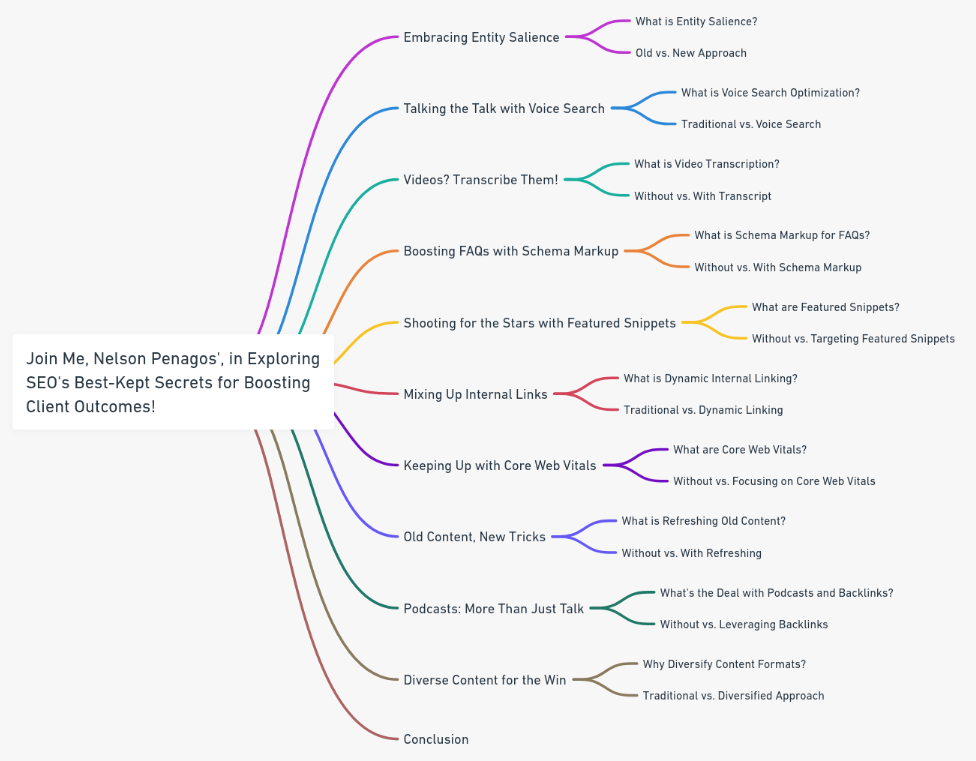
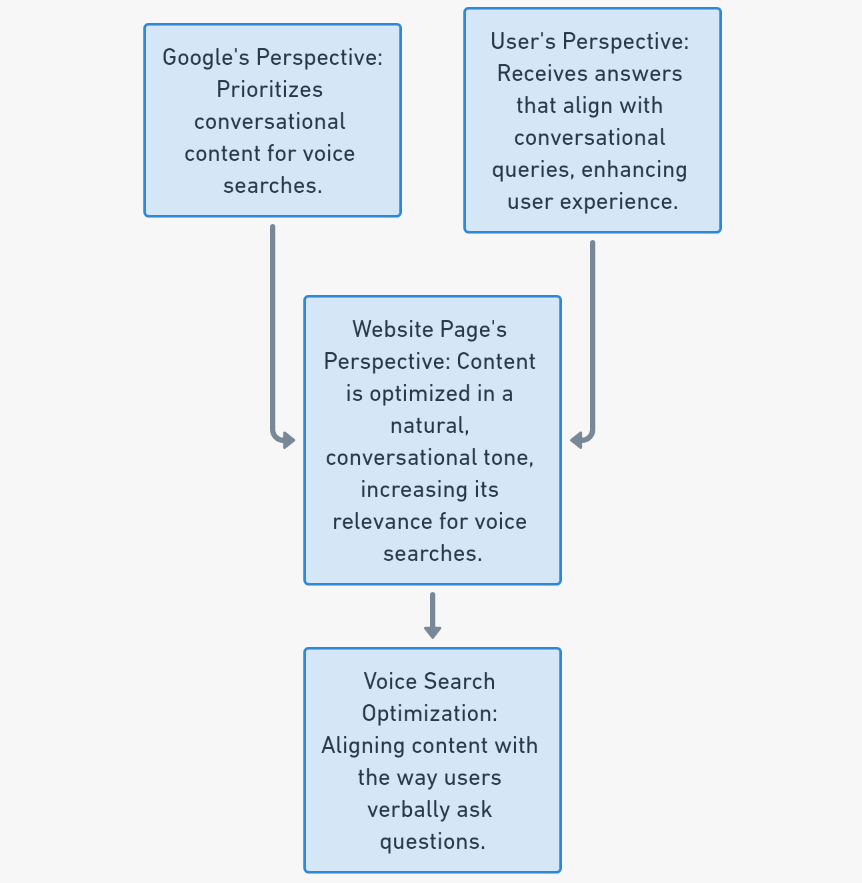
Old Approach (Text-centric): “Steps for Coffee Stain Removal from White Shirt:
- Blot the stain immediately.
- Apply liquid detergent.
- Rinse with cold water.”
New Approach (Voice Search Optimization): “If you’ve just spilled coffee on your white shirt, don’t worry! Here’s what you can do:
- First, blot the stain gently without rubbing.
- Next, apply a bit of liquid detergent directly to the stain.
- Finally, give it a rinse with cold water. This should help lift the stain.”
In the new approach:
- The content is framed in a more conversational tone, mimicking how someone might explain the process verbally.
- The steps are detailed in a natural, sequential manner, similar to how one might answer a friend asking for advice.
By optimizing content in this manner, it aligns more closely with the type of responses voice assistants aim to provide, making it more likely to be chosen as a relevant answer for voice searches.
3. Videos? Transcribe Them!: Videos are awesome, but search engines can’t ‘watch’ them. By adding transcripts, I’m ensuring that every word gets noticed, boosting visibility big time.
Let’s dive into the importance of video transcription and illustrate it with a practical example.
What is Video Transcription?
Video transcription is the process of converting the spoken content of a video into written text. While videos are a powerful medium for conveying information and engaging audiences, search engines primarily rely on text to understand and index content. By providing a transcript for videos, content creators can make the information within the video accessible to search engines, enhancing SEO and improving visibility.
Example:
Imagine you’ve created a video tutorial titled “5 Steps to Perfect French Press Coffee.”
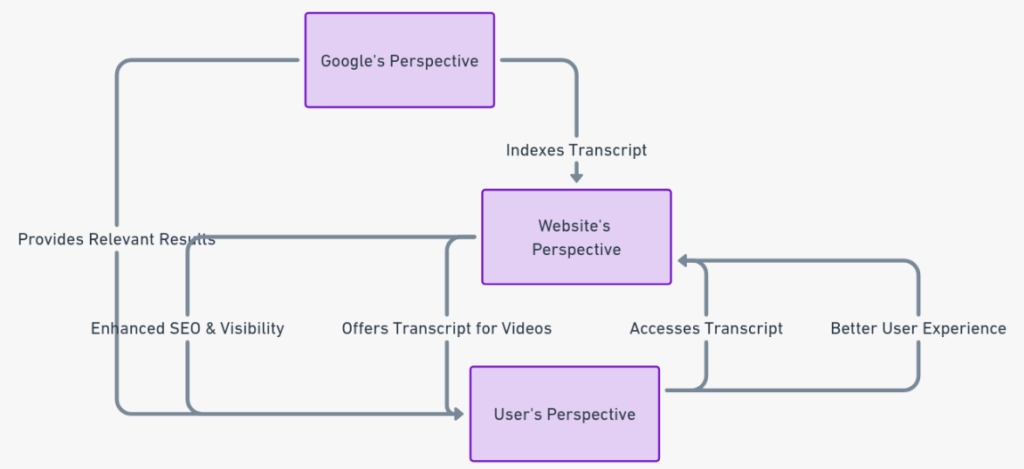
Without Transcript: Search engines see:
- Video file (e.g., “french_press_tutorial.mp4”)
- Video title
- Maybe a brief description
This provides limited context for search engines to understand the content of the video.
With Transcript: Search engines see:
- Video file
- Video title
- Detailed transcript, e.g.:
- “Welcome to our tutorial on making the perfect French Press coffee.”
- “Step 1: Measure out the coffee beans…”
- “Step 2: Boil water to the right temperature…”
- …and so on.
The transcript provides a wealth of textual information that search engines can index.
Benefits:
- Enhanced SEO:
The detailed content from the transcript can be indexed by search engines, making it more likely for the video to rank for relevant queries. - Accessibility:
Transcripts make video content accessible to individuals who are deaf or hard of hearing, broadening your audience reach. - Improved User Experience:
Users can skim through the transcript if they’re looking for specific information, without having to watch the entire video.
In essence, by transcribing videos, you’re ensuring that the rich content within them is not only accessible to viewers but also to search engines, amplifying the video’s reach and impact.
4. Boosting FAQs with Schema Markup: I’ve been jazzing up FAQ sections with some behind-the-scenes code magic. This helps those answers pop up directly in search results, making it super easy for users.
Let’s delve into the concept of using Schema Markup for FAQs and illustrate its significance with a hands-on example.
What is Schema Markup for FAQs?
Schema Markup, often referred to as “structured data,” is a form of microdata added to the backend of a webpage to help search engines better understand its content. For FAQ sections, using the specific FAQ Schema Markup can signal to search engines that the content answers common questions. This can lead to the content being displayed directly in search results, often in an enhanced format, making it more visible and accessible to users.
Example:
Imagine you have an FAQ section on a website about a new coffee machine model, and one of the questions is: “How do I clean the coffee machine?”
Without Schema Markup: Search engines see the question and answer as regular text content. While they might index it, there’s no special emphasis on the FAQ format.
With Schema Markup: Search engines recognize the structured FAQ format. When users search for “How to clean [coffee machine model],” they might see an enhanced result like:
How do I clean the coffee machine?
- “First, unplug the machine and empty the carafe. Next, fill the reservoir with a mixture of water and descaling solution. Run a brew cycle, followed by two cycles with just water…”
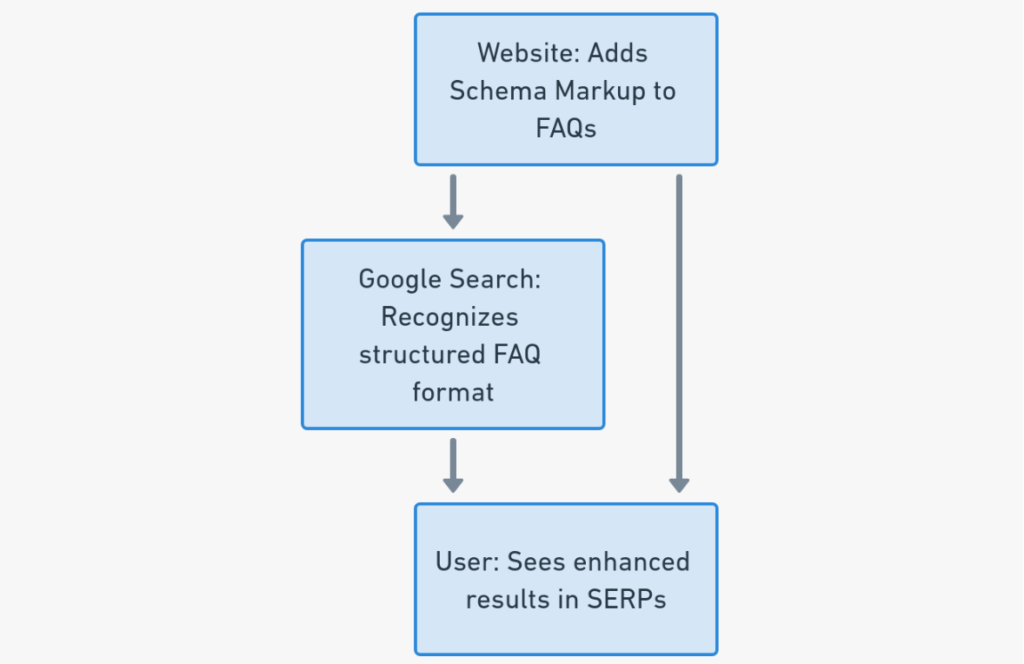
This direct answer in search results can lead to:
- Increased Visibility: The FAQ content stands out in search results, attracting more clicks.
- Higher Credibility: Enhanced results can be perceived as more authoritative by users.
- Improved User Experience: Users get direct answers without having to click through multiple pages.
Benefits:
- Direct Answers in SERPs: With Schema Markup, your FAQ content can appear as a direct answer in search engine results pages (SERPs), increasing the chances of usersb clicking on your link.
- Enhanced Search Presence: FAQs with Schema Markup can be displayed in a more prominent and visually appealing manner, making them stand out.
- Better Content Understanding: It helps search engines understand the context and structure of your content, leading to more accurate indexing.
In a nutshell, by adding Schema Markup to FAQs, you’re not just providing answers on your website; you’re potentially placing those answers directly in front of users when they search, enhancing visibility and user engagement.
5. Shooting for the Stars with Featured Snippets: Why be #1 when you can be #0? I’ve been structuring content to nab that top spot on Google, right above the first result. It’s prime real estate!
Let’s break down the concept of Featured Snippets and illustrate its value with a practical example.
What are Featured Snippets?
Featured Snippets, often referred to as “position zero,” are selected search results that appear at the very top of Google’s search results, even before the first organic result. They aim to directly answer a user’s query by extracting relevant content from a webpage. These snippets are displayed in an enhanced format, making them highly visible and clickable.
Example:
Imagine you’ve written a detailed article titled “The Ultimate Guide to Brewing the Perfect Espresso.”

A user searches for “How to brew the perfect espresso?”
Without Targeting Featured Snippets: Your article might rank on the first page, but users would need to click on the link and read through the content to find the specific steps.
Targeting Featured Snippets: You structure a section of your article with clear, concise steps:
- “Choose freshly roasted beans.”
- “Grind the beans to a fine consistency.”
- “Preheat the espresso machine…”
- …and so on.
Google recognizes this clear, step-by-step structure and displays it as a Featured Snippet:
- How to brew the perfect espresso?
- Choose freshly roasted beans.
- Grind the beans to a fine consistency.
- Preheat the espresso machine…
Benefits:
- Increased Visibility: Being at position zero means your content is the first thing users see, even before paid ads in some cases.
- Higher Click-Through Rates: Due to its prominent placement and direct answers, Featured Snippets often enjoy higher click-through rates.
- Authority and Trust: Being chosen as a Featured Snippet can enhance your content’s perceived authority on the topic.
In essence, by optimizing content for Featured Snippets, you’re not just aiming for the top spot; you’re positioning your content as the go-to answer for specific queries. It’s a powerful way to boost visibility, drive traffic, and establish authority in your niche.
6. Mixing Up Internal Links: I’m shaking things up with internal linking. Instead of the same old phrases, I’m matching links to the content’s vibe, giving search engines a fresh perspective.
Let’s dive into the concept of dynamic internal linking and illustrate its significance with a hands-on example.
What is Dynamic Internal Linking?
Internal linking refers to the practice of linking one page of your website to another page on the same website. Dynamic internal linking, or “mixing up” internal links, means varying the anchor text and linking strategy based on the context and feel of the content. Instead of using repetitive or generic phrases, the idea is to use anchor text that aligns with the content’s mood, topic, or vibe. This approach can provide search engines with a richer understanding of the content’s context and the relationships between different pages.

Example:
Imagine you have a series of articles on coffee brewing methods. One article is about “French Press Brewing,” and another is about “Espresso Techniques.”
Traditional Internal Linking: In the French Press article, you might have a link like: “Check out our guide on Espresso Techniques.” The anchor text is straightforward and directly matches the target article’s title.
Dynamic Internal Linking: In the same French Press article, you could say: “If you’re looking for a stronger kick than the French Press, dive into the world of Espresso Techniques.” Here, “dive into the world of” serves as the anchor text, giving a more contextual and engaging link to the Espresso article.
Benefits:
- Enhanced User Engagement: Dynamic linking can make internal links more engaging and contextually relevant, encouraging users to explore more content.
- Richer Context for Search Engines: Varying anchor text provides search engines with different perspectives on the content, potentially leading to better content understanding and indexing.
- Reduced Over-Optimization: Using varied anchor text can prevent over-optimization, a practice where the same keywords or phrases are used excessively, which can be flagged by search engines.
In a nutshell, by mixing up internal links, you’re not just guiding users and search engines through your site; you’re doing it in a way that’s contextually rich and engaging. It’s a subtle yet effective strategy to enhance both user experience and SEO.
7. Keeping Up with Core Web Vitals: Smooth user experiences are my thing. I’ve been ensuring sites are fast, interactive, and stable, ticking all of Google’s boxes.
Let’s delve into the concept of Core Web Vitals and illustrate its importance with a practical example.
What are Core Web Vitals?
Core Web Vitals are a set of metrics introduced by Google to measure the quality of user experience on a website. They focus on three main aspects:
- Loading Performance: How quickly the main content of a page loads (Largest Contentful Paint or LCP).
- Interactivity: How responsive a page is to user interactions (First Input Delay or FID).
- Visual Stability: How stable the content is as it loads, ensuring it doesn’t shift around unexpectedly (Cumulative Layout Shift or CLS).

Example:
Imagine you have an e-commerce website where users can browse and purchase coffee beans.
Without Focusing on Core Web Vitals: A user clicks on a product page. The images take a while to load, the “Add to Cart” button becomes clickable after a few seconds, and while browsing, the content shifts, causing the user to click on the wrong link accidentally.
Focusing on Core Web Vitals: On the same product page, the main product image loads almost instantly (LCP). As soon as the user decides to make a purchase, the “Add to Cart” button responds immediately (FID). Throughout their browsing experience, the layout remains stable, with no unexpected shifts (CLS).
Benefits:
- Enhanced User Experience: A fast, responsive, and stable site ensures users can easily find what they’re looking for without frustration.
- Improved SEO: Google has incorporated Core Web Vitals into its ranking criteria, meaning sites that perform well in these metrics may see a boost in search rankings.
- Increased Conversions: A smooth user experience can lead to higher user engagement, longer site visits, and increased conversions or sales.
In essence, by prioritizing Core Web Vitals, you’re not just optimizing for search engines; you’re ensuring that every visitor has a seamless and enjoyable experience on the site. It’s a win-win for both SEO and user satisfaction.
8. Old Content, New Tricks: Instead of churning out content non-stop, I’ve been revisiting and sprucing up the gold we already have. It’s like a content makeover!
Let’s break down the strategy of refreshing old content and illustrate its value with a hands-on example.
What is Refreshing Old Content?
Refreshing old content means taking existing articles, blog posts, or other content pieces on your website and updating them to make them current, relevant, and more valuable. This can involve adding new information, improving the structure, optimizing for SEO, or even just updating outdated references. The idea is to leverage the existing value of the content and enhance it for today’s audience and search engine algorithms.
Example:
Imagine you have an article from 2019 titled “Top Coffee Trends of the Year.”
Without Refreshing: The article remains static, discussing trends from 2019. Over time, it may lose relevance to readers and drop in search engine rankings because it’s no longer current.
With Refreshing: You revisit the article in 2023 and update it to “Top Coffee Trends to Watch in 2023.” You keep some of the evergreen content, remove outdated trends, and add new ones that are gaining popularity. You might also add new images, improve the formatting, and optimize it for any new SEO best practices.
Benefits:
- Increased Relevance: By updating the content, you ensure it remains valuable and relevant to your current audience.
- SEO Boost: Search engines like Google value fresh and updated content. By refreshing old articles, you can potentially improve their rankings.
- Cost-Effective: Instead of investing time and resources into creating new content from scratch, you’re maximizing the ROI of what you already have.
- Re-engagement: Sharing your updated content can re-engage previous readers and attract new ones, driving more traffic to your site.
In a nutshell, by giving old content a “makeover,” you’re breathing new life into it. It’s a smart strategy to ensure your content remains a valuable asset, continues to drive traffic, and resonates with your audience’s current needs and interests.
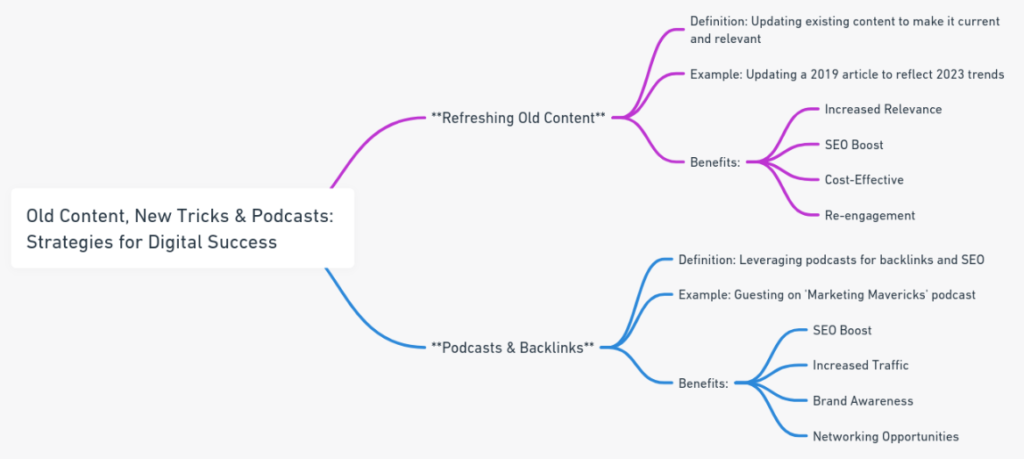
9. Podcasts: More Than Just Talk: I’ve realized podcasts aren’t just for our ears. They’re fantastic for backlinks too. Every time I’m on one, I make sure there’s a trail leading back to the site.
Let’s delve into the multifaceted benefits of podcasts, especially in the context of backlinks, and illustrate this with a practical example.
What’s the Deal with Podcasts and Backlinks?
Podcasts have surged in popularity as a medium for storytelling, education, and marketing. While they are primarily audio content, their digital nature offers numerous opportunities for SEO, especially in the form of backlinks. When you guest on a podcast or host one, the associated show notes, descriptions, and promotional content often include links. These links can lead back to your website, your products, or any other relevant page, creating valuable backlinks.
Example:
Imagine you’re invited as a guest on a popular podcast called “Marketing Mavericks” to discuss the latest trends in SEO.
Without Leveraging Backlinks: The podcast episode airs, and listeners enjoy your insights. They might remember your name or your company, but there’s no direct way for them to engage further or explore your services.
Leveraging Backlinks: In the show notes for the episode on the “Marketing Mavericks” website, there’s a brief bio about you, with a direct link to your website. Additionally, there might be links to specific tools, articles, or services you mentioned during the episode. Listeners who found your insights valuable can now easily click through, explore your offerings, and potentially become leads or customers.
Benefits:
- SEO Boost: Quality backlinks from reputable podcast sites can enhance your website’s domain authority and improve its search engine rankings.
- Increased Traffic: Curious listeners can directly visit your website, leading to increased organic traffic.
- Brand Awareness: Being featured on podcasts not only positions you as an authority in your field but also increases brand visibility.
- Networking Opportunities: Regular appearances on podcasts can lead to collaborations, partnerships, and other business opportunities.
In essence, podcasts are a goldmine for digital marketers. They’re not just an avenue for sharing knowledge but also a strategic tool for driving website traffic, building brand authority, and enhancing SEO through valuable backlinks.
10. Diverse Content for the Win: I’m stepping out of the blog box. From quizzes to infographics, I’m exploring all sorts of content avenues. The more the merrier!
Let’s dive into the strategy of diversifying content formats and illustrate its significance with a practical example.
Why Diversify Content Formats?
While traditional blog posts and articles are valuable, the digital landscape offers a plethora of content formats that can engage audiences in different ways. By diversifying content, you can cater to varied audience preferences, increase engagement, and enhance the overall user experience. Different formats can also help convey information more effectively based on the topic or the message.
Example:
Imagine you run a campaign about the “History of Coffee.”
Traditional Approach: You write a 2,000-word blog post detailing the journey of coffee from its discovery to its global popularity.
Diversified Approach:
- Infographic: A visual timeline showing the evolution of coffee over the centuries.
- Quiz: “Which Historical Coffee Era Do You Belong To?” – A fun interactive quiz for readers to engage with.
- Video: A short animated clip highlighting key moments in coffee history.
- Podcast: An interview with a coffee historian discussing interesting anecdotes and facts.
- Interactive Map: A clickable map showing the spread of coffee cultivation and consumption around the world.
Benefits:
- Enhanced Engagement: Different formats can captivate different segments of your audience, leading to higher overall engagement.
- Improved Information Retention: Visuals, interactivity, and audio can help convey and reinforce information more effectively than text alone.
- Wider Reach: Diverse content types can be shared across various platforms, expanding your content’s reach.
- SEO Benefits: Search engines value diverse and rich content, which can lead to better rankings and visibility.
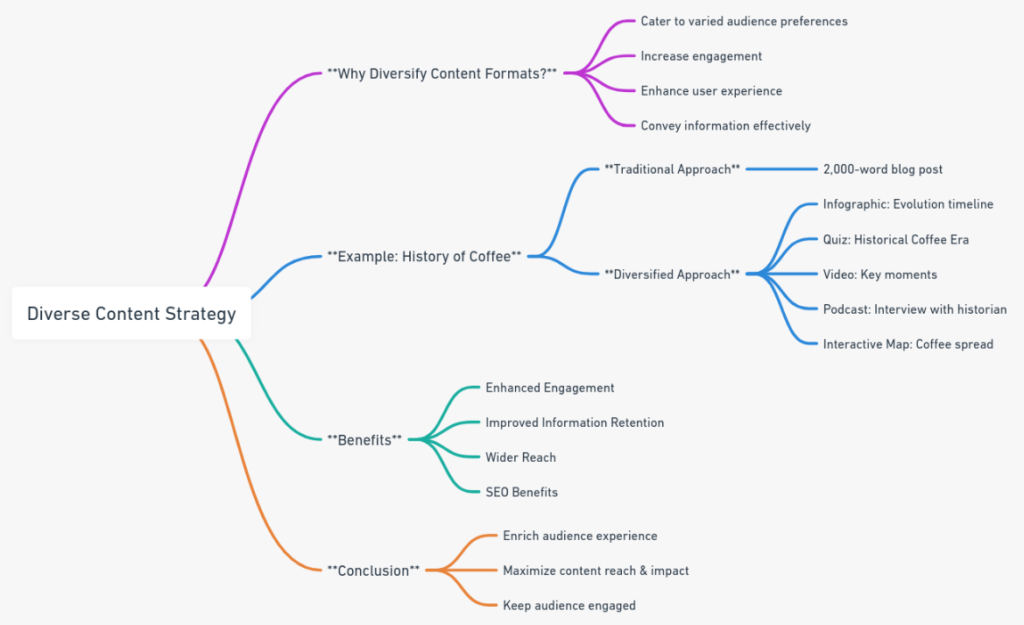
In a nutshell, by stepping out of the traditional content box and embracing a diverse range of formats, you’re not only enriching your audience’s experience but also maximizing the reach and impact of your content. It’s a dynamic way to keep your audience engaged and coming back for more.
Conclusion: In the dynamic world of SEO, staying static isn’t an option. I’m always on the move, seeking out the next big thing to ensure my clients get the best. Because at the end of the day, their win is my win. Let’s keep evolving and achieving together!
Stay tuned for more insights, and as always, let’s keep pushing the boundaries of what’s possible in SEO!



